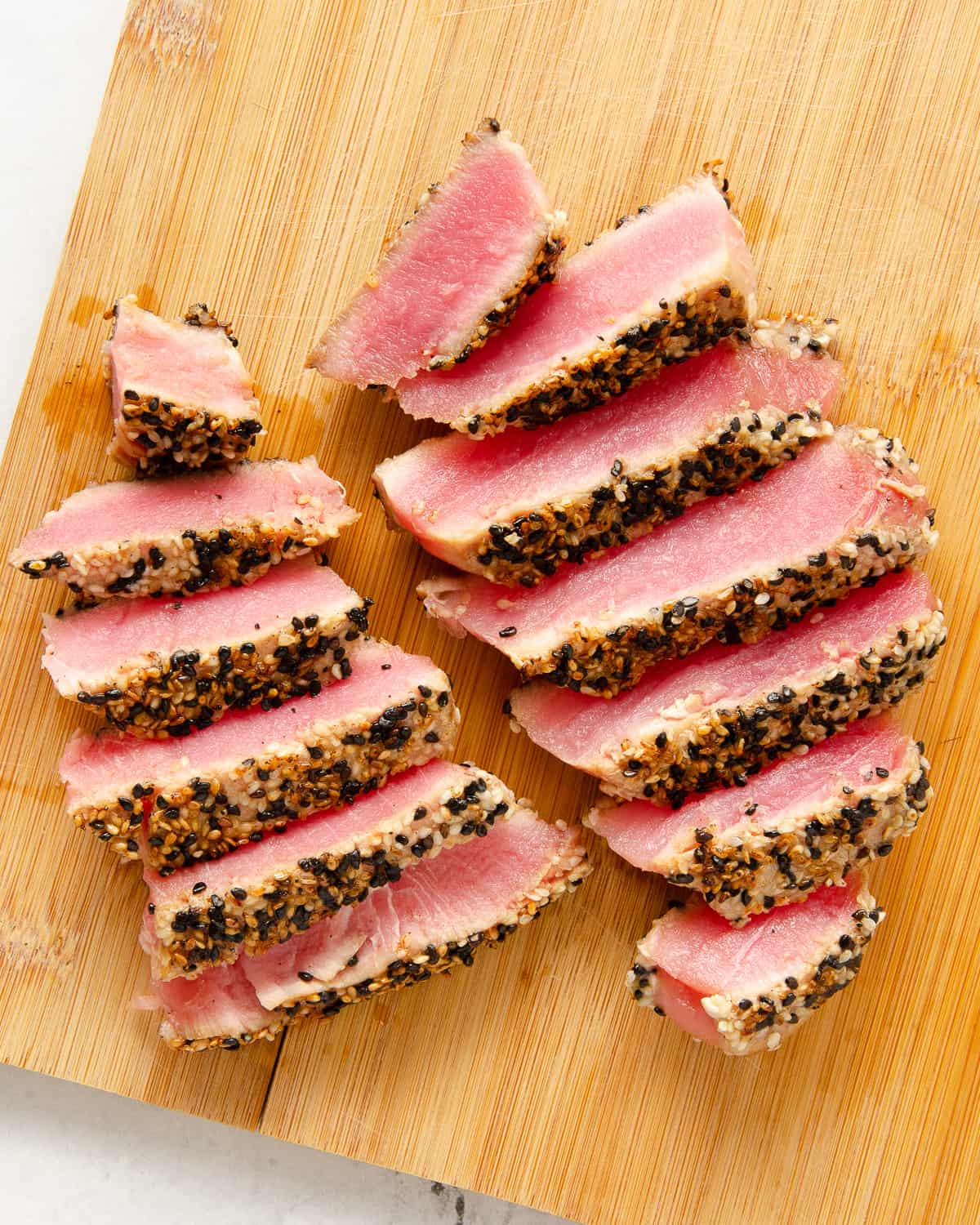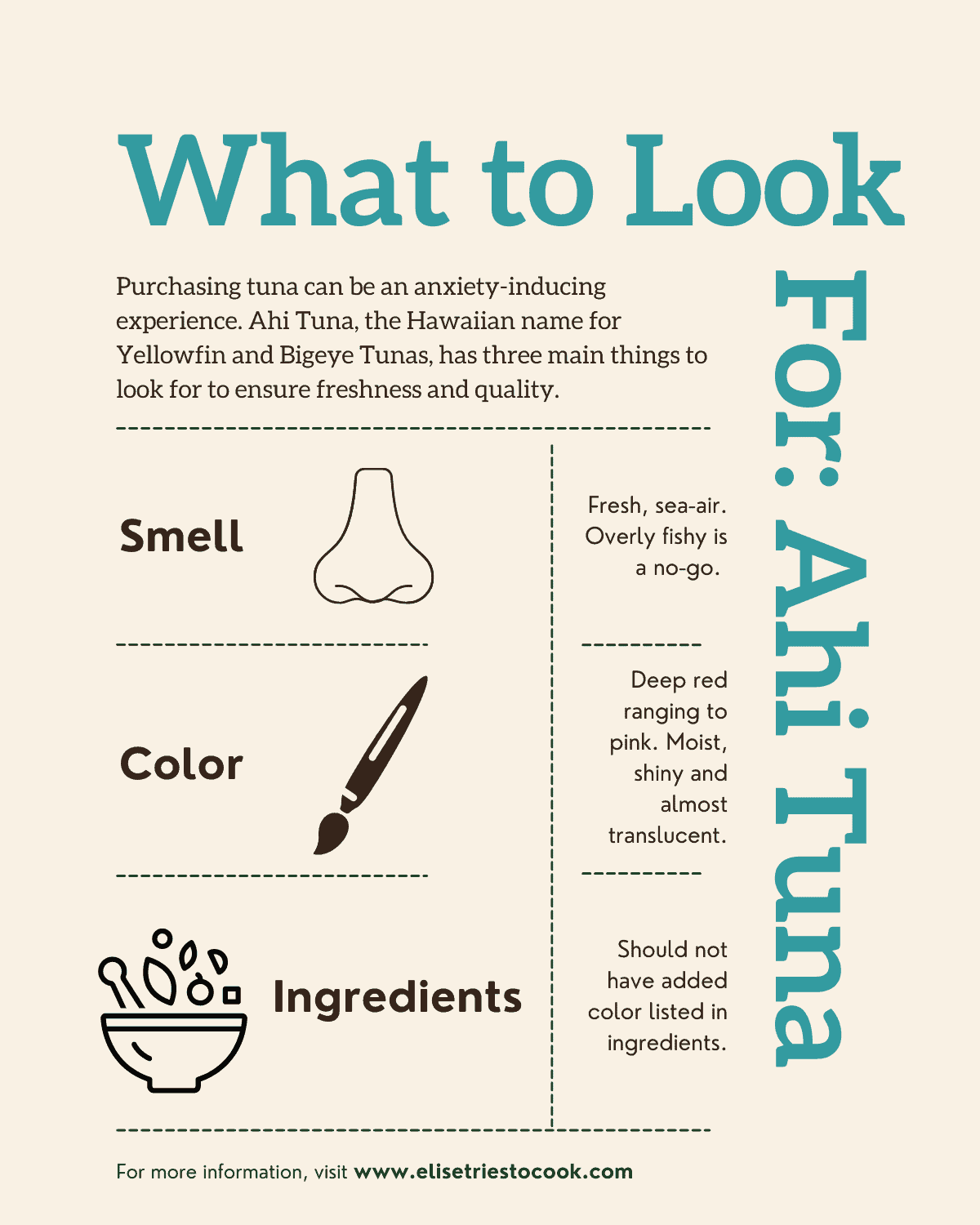In this ultimate guide to buying tuna, I explain the difference between ahi tuna, yellowfin tuna and albacore tuna (and whether they mean the same thing), where to buy it, what to look for to find the freshest tuna, and whether you really need sushi-grade ahi tuna.

Purchasing tuna, and all forms of seafood, can be an anxiety-inducing experience. How do I know the fish is fresh? What do the different names mean? Is this fish the same as one with a similar name? Where should I purchase it? These are all questions I’ve had before, so I created this ultimate guide to buying ahi tuna to help provide you with confidence!
Jump to:
What is Ahi Tuna?
Tuna is a group of fish, containing dozens of different fish. The most common types of tuna are: Skipjack, Albacore, Yellowfin, Bigeye and Bluefin.
Ahi tuna, or a species of tuna, is actually the Hawaiian name that covers to different types of tuna. It is most popularly known for being used in poke bowls or seared and served rare.
Ahi vs Yellowfin vs Albacore Tuna
Ahi Tuna
Ahi tuna is a species of tuna. Ahi tuna is the Hawaiian name for two types of tuna: Yellowfin Tuna and Bigeye Tuna. Ahi tuna has a rich, intense flavor.
Appearance: Its fleshy meat is more reddish in color.
Yellowfin Tuna
Yellowfin tuna is a sub-type of ahi tuna. Yellowfin tuna can be found along the West Coast of the United States as well as the North-East and is less commonly found than albacore tuna, hence the more expensive cost. It is named so because of its yellow markings around the fin.
Appearance: Its fleshy meat is more pink in color than traditional ahi tuna.
Albacore Tuna
Albacore Tuna, aka White Tuna, is a type of tuna, but not a type of ahi tuna. It is much smaller than ahi or yellowfin tuna and more commonly found, causing it to be less expensive. The meat is more firm and lighter or mild in flavor. Albacore tuna can be found along the West Coast of the United States as well as areas in Europe. It is often used to make canned white tuna.
Appearance: Significantly lighter in color and almost white compared to ahi tuna.

Buying Ahi Tuna
Where to Purchase
There are many places you can purchase ahi tuna. The main takeaway is to use a trusted source, like a local or online fish market.
In-Person: Trader Joe’s, Whole Foods, Gelson’s or try your favorite grocery store. (I will personally say I do not like the quality of the frozen ahi tuna from Trader Joe's.)
Thrive Market sells frozen yellowfin and albacore tuna steaks.
Catalina Offshore Products: based in San Diego, CA, Catalina Offshore Products is one of SoCal’s premier fresh and frozen seafood. They deliver to almost anywhere in the United States.
Fulton’s Fish Market: based out of New York City, Fulton’s Fish Market is one of the United States’ oldest fish markets.
Wild Alaska Salmon & Seafood Company: based out of Alaska, Wild Alaska Salmon and Seafood Company focuses on sustainable fishing.

Things to Look for when Buying Ahi Tuna
Color
The color of ahi tuna steaks range from a deep red to pink. Steaks should be moist, shiny and almost translucent.
Avoid tuna steaks that are dull, matte or brown. The longer the tuna meat is exposed to oxygen, it will begin to oxidize and turn brown, meaning a brown tuna steak may be old. Also avoid any large gaps between the muscles of the steak where it seems to be flaking off.
Smell
Tuna should have a fresh sea smell, not an overwhelming fish smell.
Ingredients
While color is a great indication of freshness in ahi tuna, some brands will actually add food coloring to make the fish appear a brighter pink color and mask any unfresh color. This is definitely NOT what we want, so make sure to double check the nutritional label and ingredients.
Do I really need to buy sushi-grade ahi tuna?
Sushi-grade is another term for the highest level of quality and freshness. It also means you can consume the fish raw. However, the FDA does not regulate the term sushi-grade, it only created a list of processes to handle fish for raw consumption.
Cooking it
As with any meat or seafood, the only real way to avoid parasites or bacteria is by properly storing and freezing the fish, or to cook it. The best part is that cooking tuna steaks is an extremely fast and easy process: sear the tuna for less than a minute on each side and you’re ready to go!
For some ideas on cooking ahi tuna, try any of the below:
Frequently Asked Questions
The best way to know if ahi tuna is bad is to smell it and look at it. If it has a sour smell, or dull grey-ish color, it is not fresh.
If purchasing extremely high-quality ahi tuna that has been frozen and stored at the proper requirements set by the FDA, you can eat ahi tuna raw. However, the safest way to consume ahi tuna is seared and served rare.
Frozen tuna should be kept in the freezer and then defrosted in the refrigerator before consuming.









Comments
No Comments